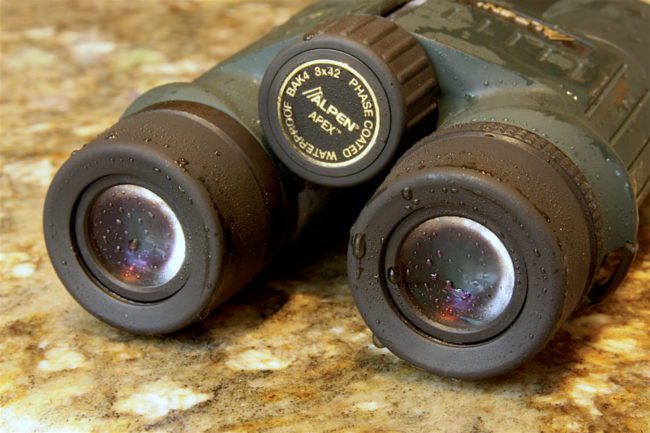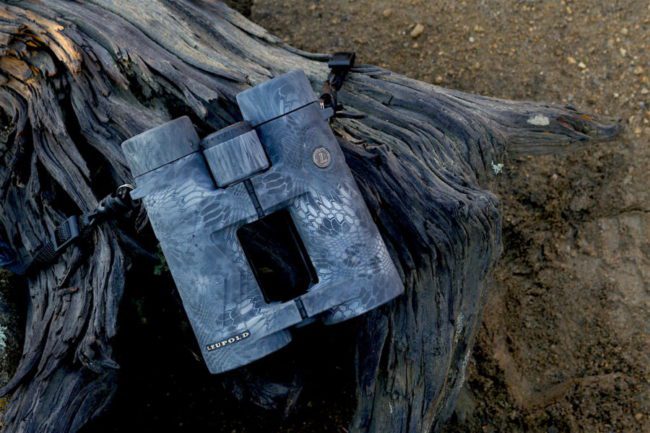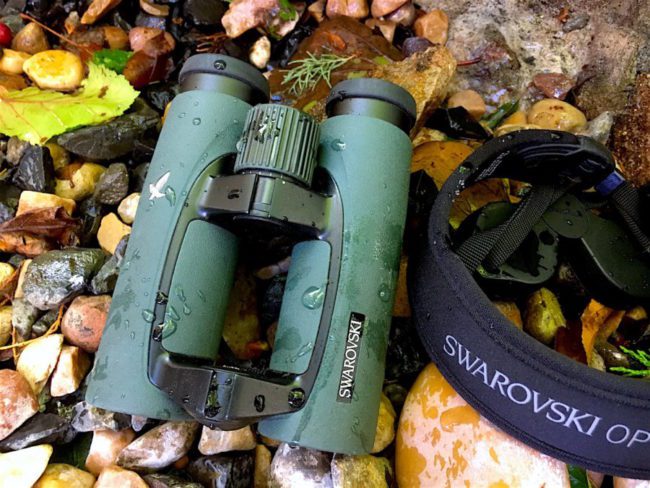Click here to read Part One of this informative article.
DIOPTER-ADJUSTMENT COMPLICATIONS
An essential but seldom-used feature on binoculars is the diopter adjustment. This thing changes the focus of one eyepiece to compensate for the visual-acuity differences between your eyes. This is much the same thing corrective eyeglass lenses do.
To use the diopter adjustment, you’re supposed to focus the binocular with the main focus wheel while looking through the non-diopter barrel, then close that eye and focus the other barrel using the diopter adjustment. After that, the center wheel will focus both barrels in concert for your sharpest view. Unless one of your eyes is declining rapidly, you don’t have to make a diopter adjustment more than once every few years, maybe not for decades. So it’s not like this needs to be super handy.
Traditionally the diopter adjustment was done via a small ring around one eyepiece. It turned quite stiffly because you didn’t want it shifting once set. End of problem. But for some reason (probably because they had to flex their muscles), binocular engineers began concocting elaborate ways to adjust diopter. Most of these involve a wheel next to or incorporated with the main focus wheel. To activate, you push or pull the wheel before turning, then snap back for the main focus work.
The problem I routinely have with these is accidentally bumping them into battery, then changing diopter of one barrel while thinking I’m focusing the entire binocular. This results in wasted time and, often, a wasted viewing opportunity. You might want to consider this when shopping.
Alas, many top-line binoculars have this feature. On some I’ve had to tape it down! Others seem a little more stable, but none as simple and effective as the old thin ring around one eyepiece. I wish engineers and manufacturers would stick to the KISS system: Keep It Simple, Stupid.

Most binoculars are guaranteed waterproof these days, so why not test that by submerging them at home so you’ll have time to return for a replacement — just in case? This Alpen Apex, street price around $300, passed high and dry.
BEST SAFARI BINOCULAR IS DUSTPROOF, WATERPROOF, FOGPROOF
Get one of these attributes and you generally get all three, and nearly all binoculars now advertise them. But there are degrees of waterproof-ness. The deeper the water, the more likely a seal will leak because pressure increases. You might fall into a lake or river and go ten feet under for a few seconds, but most likely you’ll just get rained on, so don’t feel as if you need a “waterproof to 30 feet for 30 minutes” guarantee.
By the way, to test the waterproof guarantee, submerge your binocular in a sink of water right after you get it. If it leaks, you’ll have time to return it for a refund, replacement, or repair.
Fogproof means the instrument isn’t supposed to fog internally, which happens if there is warm moisture inside and you drag the binocular into cold air. Virtually all binoculars prevent this by sucking the air out and replacing it with nitrogen or argon gas. As long as the seals hold and no humid air leaks in, they shouldn’t fog internally. External lenses can still fog if they’re cold and you breathe on them, but that won’t happen often on safari.
Special external lens coatings like Swarovski’s Swaroclean, Leupold’s Guard-iON, Zeiss’s LotuTec are so hard and slippery that fog droplets can’t easily cling to them. Instead of fogging, the droplets coalesce into larger drops and roll off. This isn’t often needed in a safari binocular but will be when you get home for your fall and winter North American hunts.

So-called armor coating — a rubber-like skin — isn’t a major requirement in a binocular, but it protects from dents and scratches, so why not? This Leupold BX-3 Mojave 10×42 is another example of today’s Best Buy roof-prism binoculars in the $300 to $500 range.
ARMOR UP YOUR BEST SAFARI BINOCULAR
Virtually every binocular these days wears a rubberized cover. These enhance grip and protect against dings and scratches, but they aren’t exactly a Star Trek force shield. Don’t go pounding nails and bashing rocks with them.
Still, armor coatings are worth getting. So are twist-up eye cups. Roll-up-and-down rubber eyecups seem adequate until they age a bit and begin to crack. Twist-up cups are more durable and useful, especially the ones that lock into position. The reason for adjustable eye cups is to accommodate different eye-socket depth and eyeglass wearers. At the right extension, eyecups can prevent oily eyelashes from smearing eyepiece lenses, too. Cup rims should be rubberized to prevent scratching eyeglasses. Press eye cups against your glasses or brow to help reduce vibrations.
Another useful protector is an eyepiece cover of some kind. I don’t use objective lens covers because those are always pointing down while I wear the binocular. The eyepiece lenses, however, point up at my chin and catch everything from leaves and falling road dust to nose drippings and crumbs from a mid-morning snack. You want eyepiece covers that stay on yet come off with a flick of a thumb.
Study these carefully when shopping. Some are hard and don’t grip well enough to stay on. Others are too soft and difficult to attach in the first place. You might find an aftermarket binocular pouch or cover a better option than eyepiece covers. They’ll offer better dust protection for the entire instrument, too, but might slow down employment, so test carefully. I want my binocular to be instantly ready. I don’t want to have to zip them from a case.

If you have the cash and simply want one of the best safari binoculars in the world, just grab the compact, 21-ounce Swarovski 8×32 and never look back. Incredible performance in a light, compact package that travels easy.
MAKE A COMMON-SENSE COMPROMISE IN YOUR SAFARI BINOCULAR SIZE AND POWER
When you travel, everything becomes a compromise. Over the years I’ve discovered I find, watch, and enjoy glassing more wildlife with an 8x32mm binocular than any other. Why? Because it is the perfect compromise among weight, portability, brightness, and field of view. A 10X would add a bit of reach, a 50mm objective a bit of light, but the additional size and bulk would tempt me to leave them in the truck more often. A 6X would give me a bit more field of view, but I might regret them when trying to identify small antelope 400 yards across a meadow.
Consider such practical matters when choosing your best safari binocular, but do not leave home without one. You’ll see and enjoy so much more with magnified vision, and you’ll actually get more hours of use out of your binocular than your rifle and scope.
CONCLUSION
The most popular all-round binocular is the roof-prism 8×42 or 10×42. Because of weight, size, and travel convenience issues, my favorite safari binocular is an 8×32 roof prism with phase-coated Schott glass (the best), BaK4 prism glass, dielectric mirror, field-flattener lens, and fully multicoated lenses with an HD/ED lens to minimize color fringing. Yowser! This instrument is incredible, and the view through them almost takes your breath away.
For more from Ron Spomer, check out his website, ronspomeroutdoors.com, and be sure to subscribe to Sporting Classics for his rifles column and features.

